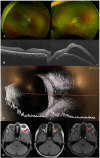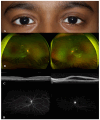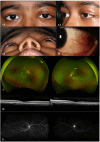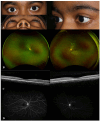IgG4-related ophthalmic disease presenting as posterior scleritis in a pediatric patient
- PMID: 40146480
- PMCID: PMC11950618
- DOI: 10.1186/s12348-025-00459-9
IgG4-related ophthalmic disease presenting as posterior scleritis in a pediatric patient
Abstract
Purpose: To report IgG4-related ophthalmic disease (IgG4-ROD) presenting as posterior scleritis in a pediatric patient.
Observations: A 7-year-old girl presented with proptosis, painful eyelid swelling, and restricted extraocular movements (EOM) of her left eye (OS). Visual acuity (VA) was 20/20 in right eye (OD) and counting fingers (CF) at 1 foot in OS. Slit lamp examination revealed 2 + anterior chamber (AC) cells, optic disc edema (ODE) with elevated appearance of macula in OS. Optical coherence tomography (OCT) showed significant subretinal fluid (SRF) in macula, B-scan ultrasound (US) demonstrated T-sign in OS. Orbital MRI was also consistent with posterior scleritis and periorbital inflammation. Extensive systemic work-up was unremarkable. Thus, the patient was started on intravenous methylprednisolone (IVMP) 30 mg/kg/day for 3 days, along with topical therapy in OS, which led to an improvement of proptosis, EOM restriction, AC cells, as well as ODE and SRF in macula in OS. Fluorescein angiography (FA) showed leakage from optic disc in OS. The patient was then switched to oral prednisone with slow tapering and started on methotrexate (MTX). Given the recurrence of proptosis and painful eyelid swelling on systemic steroid tapering, serum IgG4 levels were ordered and found to be elevated at 149.9 mg/dL (range, 1-99). Therefore, the patient was diagnosed as 'possible' IgG4-ROD (based on diagnostic criteria) and started on infliximab (7.5 mg/kg) and IVMP monthly infusions with continuation of MTX 20 mg weekly and slower tapering of oral prednisone, which led to resolution of clinical findings, improvement of VA to 20/20 in OS.
Conclusion and importance: Posterior scleritis may be the initial presentation of IgG4-ROD in children. Refractory course is not uncommon. Biologics are effective in the long-term control of inflammation.
Keywords: IgG4-related ophthalmic disease; Infliximab; Pediatric; Posterior scleritis.
© 2025. The Author(s).
Conflict of interest statement
Declarations. Ethics approval and consent to participate: Ethics approval was obtained from The Stanford University Institutional Review Board, and informed consent was obtained from the patient’s parent. Consent for publication: Consent for publication was obtained from patient’s parent. Competing interests: The authors declare no competing interests. Meeting presentation: None.
Figures





Similar articles
-
Combined anterior and posterior scleritis associated with central retinal vein occlusion: a case report.J Ophthalmic Inflamm Infect. 2012 Sep;2(3):165-8. doi: 10.1007/s12348-012-0066-x. Epub 2012 Mar 13. J Ophthalmic Inflamm Infect. 2012. PMID: 22411459 Free PMC article.
-
Anti-interleukin-6 receptor therapy with tocilizumab for refractory pseudophakic cystoid macular edema.Am J Ophthalmol Case Rep. 2020 Aug 20;20:100881. doi: 10.1016/j.ajoc.2020.100881. eCollection 2020 Dec. Am J Ophthalmol Case Rep. 2020. PMID: 32875161 Free PMC article.
-
IgG4-related ophthalmic disease masquerading as ciliary body tumors and scleritis in both eyes: a case report.BMC Ophthalmol. 2023 Mar 9;23(1):92. doi: 10.1186/s12886-023-02822-7. BMC Ophthalmol. 2023. PMID: 36894878 Free PMC article.
-
Multimodal Imaging of Nodular Posterior Scleritis: Case Report and Review of the Literature.Middle East Afr J Ophthalmol. 2020 Jul 20;27(2):134-138. doi: 10.4103/meajo.MEAJO_115_20. eCollection 2020 Apr-Jun. Middle East Afr J Ophthalmol. 2020. PMID: 32874049 Free PMC article. Review.
-
IgG4-related disease in the eye and ocular adnexa.Curr Opin Ophthalmol. 2017 Nov;28(6):617-622. doi: 10.1097/ICU.0000000000000427. Curr Opin Ophthalmol. 2017. PMID: 28858963 Review.
References
-
- Jabs DA, Mudun A, Dunn JP, Marsh MJ (2000) Episcleritis and scleritis: clinical features and treatment results. Am J Ophthalmol 130(4):469–476. 10.1016/s0002-9394(00)00710-8 - PubMed
-
- McCluskey PJ, Watson PG, Lightman S, Haybittle J, Restori M, Branley M (1999) Posterior scleritis: clinical features, systemic associations, and outcome in a large series of patients. Ophthalmol 106(12):2380–2386. 10.1016/S0161-6420(99)90543-2 - PubMed
-
- de la Sainz M, Jabbur NS, Foster CS (1994) Severity of scleritis and episcleritis. Ophthalmol 101(2):389–396. 10.1016/s0161-6420(94)31325-x - PubMed
-
- Majumder PD, Ali S, George A, Ganesh S, Biswas J (2019) Clinical Profile of Scleritis in Children. Ocul Immunol Inflamm 27(4):535–539. 10.1080/09273948.2017.1423333 - PubMed
LinkOut - more resources
Full Text Sources
Miscellaneous

